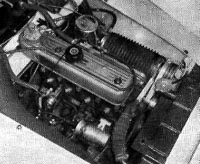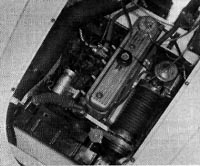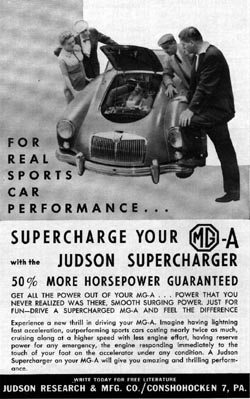Road Test: Supercharged MGA Judson, Road & Track, May 1958
The best boost in go for the least in dough
For nearly 10 years we have been taking the attitude that the performance of a given sports car must be evaluated with due allowance for its engine size. The only trouble is that everyone seems to want more. The MG is a perfect example: no sooner had they come out with the "A", offering truly competitive performance for a 1.5 litre car, when along came our readers asking for more. Personally, we feel that 0 to 60 in 14.2 seconds and a top speed of 97 - 100 honest mph (which the stock MGA does) should satisfy anyone.

MGA Test Car - "Continental" kit nullified performance benefit gained by blower installation.
The truth is that although sports cars are gradually becoming accepted for what they are (maximum performers for a given class), there are still many people new to the sport who do not understand. Inevitably, since the MG is the lowest-priced sports car, it becomes susceptible to the wiles of the sorcerer, in the case Judson of Conshohocken, PA.
Judson say that their supercharger offers 50% more power. Though the car does indeed take on a new character, the truth is closer to 25%. However, even that much of a boost is well worthwhile, as shown by the tabulation which appears in the next column.

This order of improvement, plus a comparison of other data, indicates that the Judson supercharger gives the MG a very close equivalent to 25% more torque and boosts the peak horsepower from 72 to 90, and no more. But the point is that performance is improved as if the 1.5 litre MG engine were enlarged to 1.9 litres.
| Test Results | Stock | Judson | |
|---|---|---|---|
| 0-30 mph | 4.5 | 3.8 | |
| 0-60 mph | 14.2 | 12.5 | |
| 0-80 mph | 29.0 | 25.0 | |
| Standing start | |||
| 1/4 mile | 19.6 | 18.1 | |
So, the advantages of a Judson supercharger are stated factually in terms of performance gain - what are the disadvantages? In the first place, supercharging is a matter of degree. It can give fabulous power gains by using plenty of boost, but it is high boost pressures which have given supercharging a bad name. The Judson MG kit is designed to give modest manifold pressures of about 5.5 pounds per square inch maximum.
Then we must consider the fundamental principles involved. Judson superchargers are the vane type, which means positive displacement. This type of supercharger gives its performance gain at all speed, which is important.

No alteration of panel was necessary to install blower.

Kit contains everything needed for owner installation.
The disadvantage of vane-type superchargers has always been the rubbing friction of the vanes. Here Judson have shown excellent engineering know-how by mixing good common sense with the very latest techniques. The Judson's vanes are at an angle (not radial), so that the centrifugal forces are virtually, but not quite, canceled. Additionally, the vanes (or blades) are made from a laminated plastic material which weights half as much as aluminum and which is dimensionally stable at all temperatures from 50 degrees below zero to 300 degrees Fahrenheit. Similar vanes are used commercially by Ingersoll-Rand (portable air compressor) and Thor Power Tool (air-powered grinder). A small amount of lubricant is used (about one quart per 1000 miles) but the exact amount is not at all critical.
For this purpose, Judson supplies with the kit an aluminum rocker arm cover which incorporates a metering valve, readily adjustable to give one drop of oil every 4 to 6 seconds at idle. Incidentally, the lubricant is SAE 10, or Marvel Mystery Oil. Judson warns, "do not use any other type or brand of upper cylinder lubricant, as most top oils are primarily a cleaner and not a lubricant." To which we can only add "Amen."
Insofar as the driver's job is concerned, there is absolutely no difference in any way. We did encounter some clutch slip after five consecutive "all-out" standing starts. For the flat-out, always-on-the-floor type of driver, the special competition clutch is necessary. but we honestly feel the most MG owners will not need, or want, the heavy-duty clutch.
The engine itself sounds no different when supercharged. Peak bearing loads are actually decreased, because the higher combustion pressure opposes the inertia forces which tend literally to throw the piston up into the cylinder head. Occasionally there is faint noise ( a sort of clatter) from the vanes. This is normal and no cause for concern.
The car tested is the property of Bill Corey, who writes our monthly "Tune-Up Clinic." It received no special tuning at his shop and is, according to its owner, not so good a performer as some other examples which have received the same treatment. Judson recommends that a Bendix fuel pump be used for speeds over 90 mph (one way). However, this run was with top down and with the continental kit shown. The latter item may not seem important, but we ran parallel tests for drag losses on the Tech Ed's MGA and got the following data with the Tapley meter at 60 mph:

| Test Results | Stock | Test Car | |
|---|---|---|---|
| Test weight, ton | 1.080 | 1.195 | |
| Calculated rolling resistance | 20 | 22 | |
| Tapley drag, top and | |||
| curtains up, lb/ton | 90 | - | |
| Same, lb force | 97 | - | |
| Tapley drag, top down, | |||
| lb/ton | 100 | 107 | |
| same, lb force | 108 | 127 | |
| Net air drag, top | |||
| down, lb force | 88 | 105 | |
From this it is obvious that the continental kit makes for considerable extra air drag and has a marked effect on the timed top speed. However stock MG trunk space is almost a joke and the continental kit is certainly a useful accessory, even if it does take a supercharger to bring back the original top-speed capability. Actually, the supercharger makes an MG with continental kit and top down about as fast as a stock machine with the top up and side curtains in place. Accordingly we rate the true top speed of the supercharged roadster as 105 mph; the coupe, with its radiused windshield, might be able to touch 110 mph when well tuned and equipped with a Bendix fuel pump. Accordingly to a power-required curve supplied us by the MG company, a speed of 98 mph requires exactly 68 bhp. A few calculations with the aid of a slide rule show that a speed of 110 mph would require 90 bhp.
The biggest change noted on the first driving this car is the improved high-gear flexibility. This was borne out by the Tapley meter, which shows nearly 25% better pulling power (torque) in the gears. Grades which formerly required 3rd gear can now be climbed rapidly in high, although this is not say that high gear supercharged is as good as 3rd gear unsupercharged. Incidentally the speedometer error was virtually nil because Corey has substituted 165 x 380 mm. Michelin tires which turn 792 revs per mile, as compared to the standard equipment 5.a60 x 15s which give 810 revs per mile. This change actually reduces the high-gear ability: the net result is just as if a 4.21 axle ratio were being used.
Fuel consumption suffers surprisingly little in normal driving. Under quite variable conditions we got 26 mpg consistently. However, during the test the extra horsepower used more fuel--we got 19 mpg. We mighty also mention that this car was 90 pounds heavier than a purely stock MGA because of various accessories and undercoating.
The price of the Judson kit is given in the data panel includes a properly calibrated carburetor (Holley) and a special exhaust manifold, as well as all necessary small parts. Installation would take an owner about five hours with the manufacturers very explicit instructions. The flat rate for installation at Bill Coreys shop is $35.00, but this includes a dynamometer tune-up.
If you like your MGA but want more go, this is the answer.
















No comments have been posted yet...
Want to leave a comment or ask the owner a question?
Sign in or register a new account — it's free